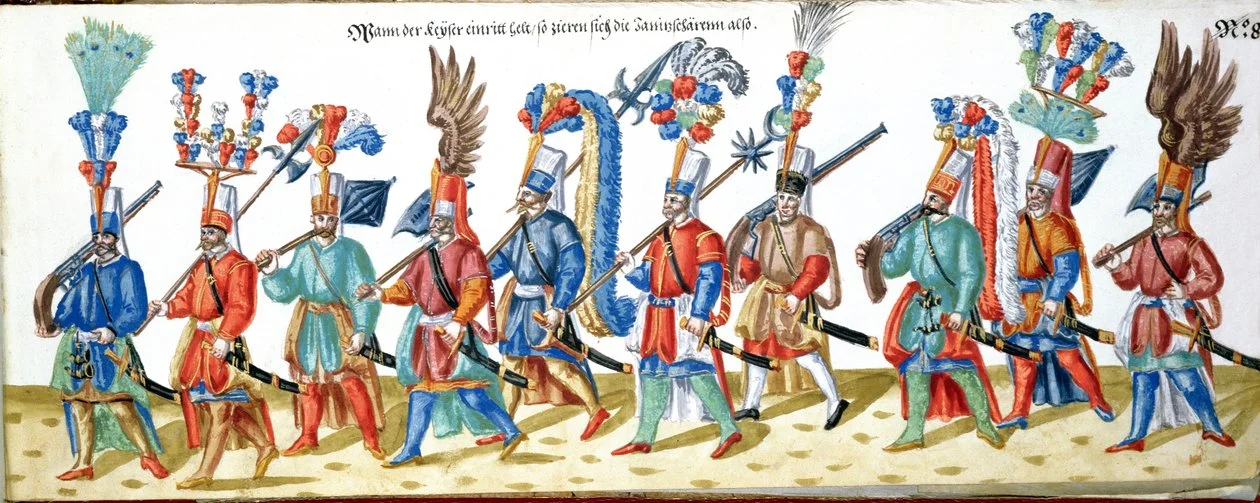The Janissaries, or ‘New Army’, were an elite unit of the Ottoman army for which handsome and strong Christian boys were selected from the Balkan provinces of the empire. In daily life they were similar to Sufi mystics, but on the battlefield, they caused terror and panic. Why did the sultans need these unusual and fearsome warriors? How did these young boys become janissaries, how did they live and train, and why were they eventually disbanded? Qalam has the answers to all of these questions and many more.
This is the first part of our story about the Janissaries. You can read the second part here.
The grand vizier of the Seljuk Empire Nizam al-Mulk wrote in his monumental work Siyasatnama (The Book of Government) that one obedient slave is better than 300 sons because the latter yearn for the death of their father, while the former yearn for the glory of their master. The Ottoman sultans decided to create a whole army of slaves, but their dream of obedience was never achieved. The Janissary Corps were capricious and demanding, frequently meddling in politics and often determining who should be vizier or even sultan. Some of them—Slavs, Greeks, and Christians by birth—reached the pinnacle of power in the Muslim Ottoman Empire.
On 17 August 1474, Grand Vizier Veli Mahmud Pasha (1420–1474), adored by the people, worshipped by poets and artists, was executed in the most guarded prison of the empire, the Yedikule Fortress. Known as Mahmud Pasha Angelović and by his poetic pseudonym Adnî (meaning ‘the Eden-like’ in Turkish), his death marked a significant moment in the empire's history. A great military leader and admiral of the Ottoman Navy, poet, urban planner, patron of the arts and poetry, who had served as grand vizier, the second-highest rank in the empire after the sultan, for more than fifteen years, he fell out of favor with Sultan Mehmed II the Conqueror (1444–46, 1451–81), was dismissed from office, and was soon executed. His execution sparked endless political intrigue and literary speculation, partly because he was accused of murdering Mustafa, the crown prince and favorite son of Mehmed the Conqueror.
According to Ottoman sources, Mahmud Pasha poisoned Mustafa because he suspected him of having an affair with his second wife. He divorced his wife, of course, but did not forgive the prince. According to contemporaries, the dying şehzade Mustafai
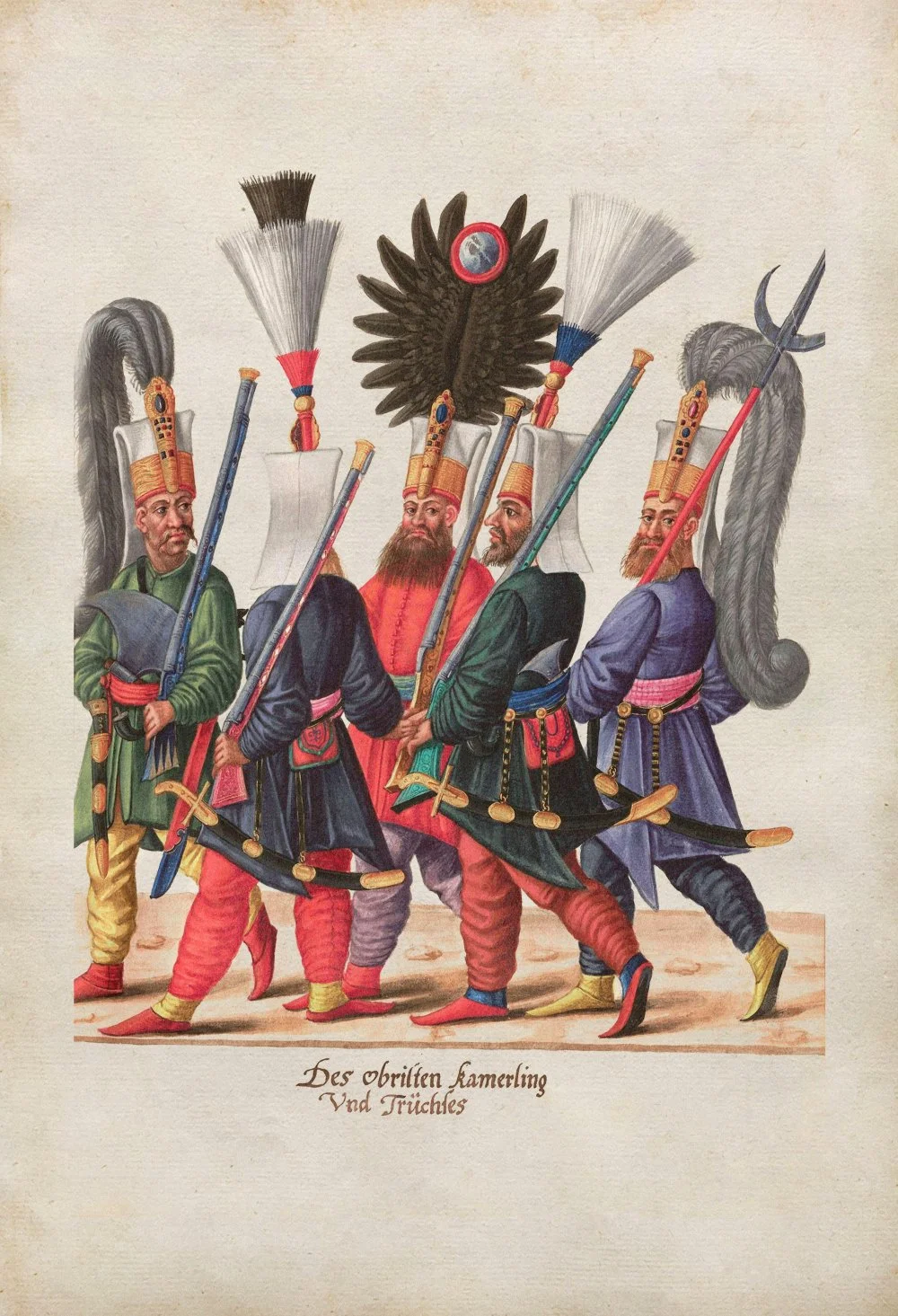
The History оf Ottoman Empire. Janissary Soldiers. From Pictures From Turkish Folk Life By Heinrich Hendrowski. 16th Century/Alamy
Mahmud Pasha, nicknamed Velii

Creating the Brand
Although there were only a few Janissaries in the Ottoman army at the time of the European conquests, this ‘new army’, which is how yeniçeri is translated from Turkish, quickly spread fear and dread across three continents and became legendary. Everyone was afraid of the Janissaries because they were the first to climb the city walls or attack the enemy’s defenses. Their boldness and ruthlessness inspired many songs and legends, turning them into almost mythical figures. Even official reports shrouded them in a mysterious aura.

Jacopo Ligozzi «A Janissary "of War" with a Lion», ca. 1570–80/The Metropolitan Museum of Art, New York, Harris Brisbane Dick Fund, 1997 Bostanji bachi leu/Alamy
The Janissaries’ military prowess was undeniable, and they played a key role in winning many battles for the Ottoman Empire, only adding to their reputation. This reputation soon turned into an important Ottoman brand, often winning battles before the fighting even began. Thus, for example, only 6,362 Janissariesi
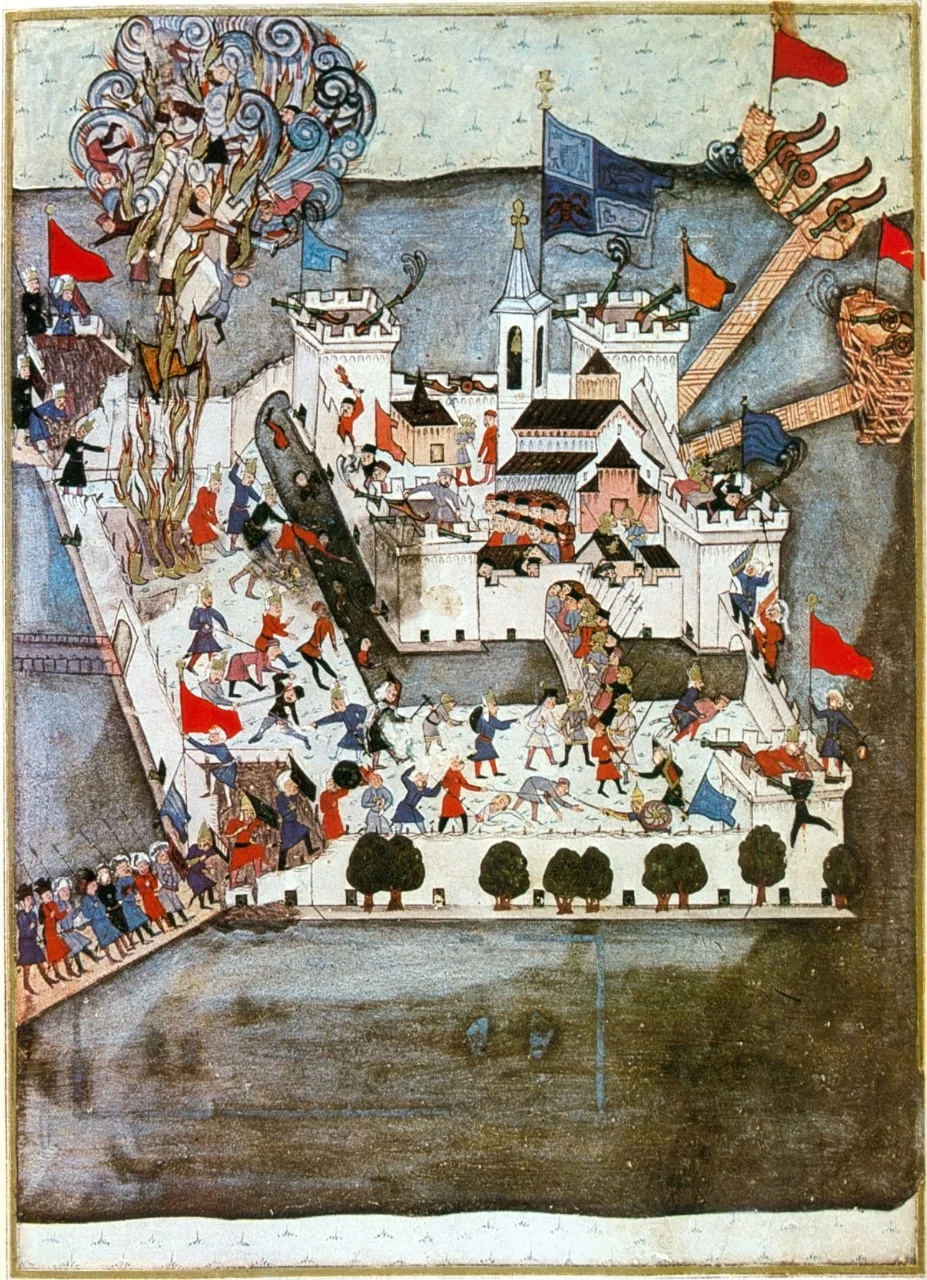
A miniature showing the siege of Szigetvár, 16th century/Wikimedia commons
In Europe, the Janissaries’ reputation spread far and wide. They were compared to the fearless phalanxes commanded by Alexander the Great. The famous Florentine historian Scipione Ammirato (1531–1601) spoke of creating similar troops, recruited from orphans, to serve Christianity. During Shakespeare’s time, characters dressed as Janissaries appeared more and more often in English plays. Even in Othello, there was a reference to Sultan Mehmed II’s concubine Irina, who was executed in Constantinople under pressure from the Janissaries. The literature of Central and Eastern Europe depicted them in a variety of ways. Some popular tales sang of their love affairs with women in the provinces of the Ottoman Empire, and others explored their confessions. There were still other stories that showed them as patriots who rose up in defense of their people after hearing Slavic speech.
Their reputation within the country was not hollow or any less frightening than abroad. They were the private guard of the sultan, but they also maintained public order, served as bailiffs, and even as executioners. They were the ones who closed taverns and shops, beat up drunkards, and put criminals to death. However, this image wasn't entirely undeserved. The Janissaries themselves were known to indulge in alcohol and cause trouble, acquiring a reputation as rowdy and unruly.
Men of Fashion and Rhythm
The great fame of the Janissaries was partly due to their distinctive appearance and creative brand management. It was impossible not to notice them in their bright red caftans, leather vests embroidered with golden motifs, and stylish red and yellow shoes and boots. Their high, completely impractical, but impressive white headgear was made from fine felt and adorned with golden or silver insets or sometimes with precious stones made them even more impressive to look at. Their headgear, made in the shape of a folded sleeve, known as börk, symbolized their affiliation with the Sufi order and was also dubbed the Bektaşi tâcı (Bektashi crown).
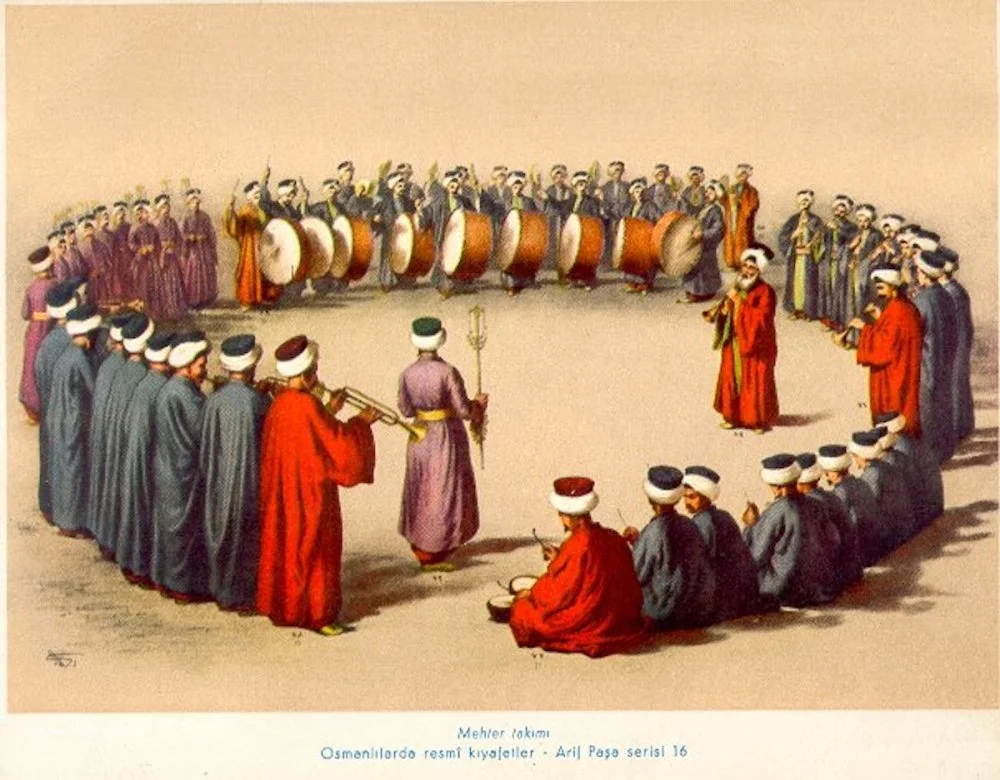
Mehterhane, Military Band, 1839. Painted by Arif Pasha/Public domain
They also had beautiful twisted mustaches that stood out from afar on their freshly shaved cheeks. Their distinguishing features, however, went beyond their clothing and facial hair. The Janissaries could be identified, even in the baths, by special tattoos on their arms and legs that indicated their regiment and branch of service.
By law, the state provided the Janissaries uniforms at its own expense, and any delays could cause outrage as cleaning and repairing these garments became one of their distinctive routines. They enjoyed showing off their outfits and would adorn them with extra feathers during military campaigns. Some historians believe that their red and yellow shoes decisively influenced European fashion, while their börks inspired the headgear of high-class women in Western Europe.i

German (Swabian) School “Portrait of a Woman of the Hofer Family”, about 1470 /The National Gallery, London
While a janissary was punished and expelled from the corps for any faults and felonies, they were publicly deprived of their headgear and boots, marking them as ‘fallen’ or ‘downcast’ (düşkünler). Thus, it is also no surprise that the traditional shoe industry in the Ottoman Empire began to decline in 1926, the year the Janissaries were abolished.
On the battlefield, everyone would notice the approaching Janissaries by their military band Mehter,i
of the Janissary band is said to have even inspired Mozart and Beethoven to compose Turkish marches, which were later imitated by everyone from Liszt to Rachmaninoff.
Despite the ruthless bloodthirstiness with which they were always associated, the Janissaries somehow always left people with a cheerful, and even overly friendly, impression in personal interactions. Ogier Ghiselin de Busbecq, the ambassador of the Holy Roman Empire in Istanbul, the same man who confused the name of the tulip with that of the turban (tülbent) and gave Europe a new flower along with its name, describes the Janissaries he personally met and even dined with not far from their garrison in Buda, Hungary, in his memoirs, The Turkish Letters.i
Busbecq was impressed by their long caftans and huge headdresses. According to him, they always walked in pairs, bowed in a friendly manner when greeting others, as if to kiss their hands, and offered hyacinths and daffodils to the envoy when they greeted him. He made mention of their taciturnity, their respectful bowing with their arms crossed across their chests and their downward gaze, and, strangely enough, their love of money. ‘To tell you the truth, if I had not been told beforehand that they were Janissaries, I should, without hesitation, have taken them for members of some order of Turkish monks, or brethren of some Muslim college. Yet these are the famous Janissaries, whose approach inspires terror everywhere,’ he wrote.
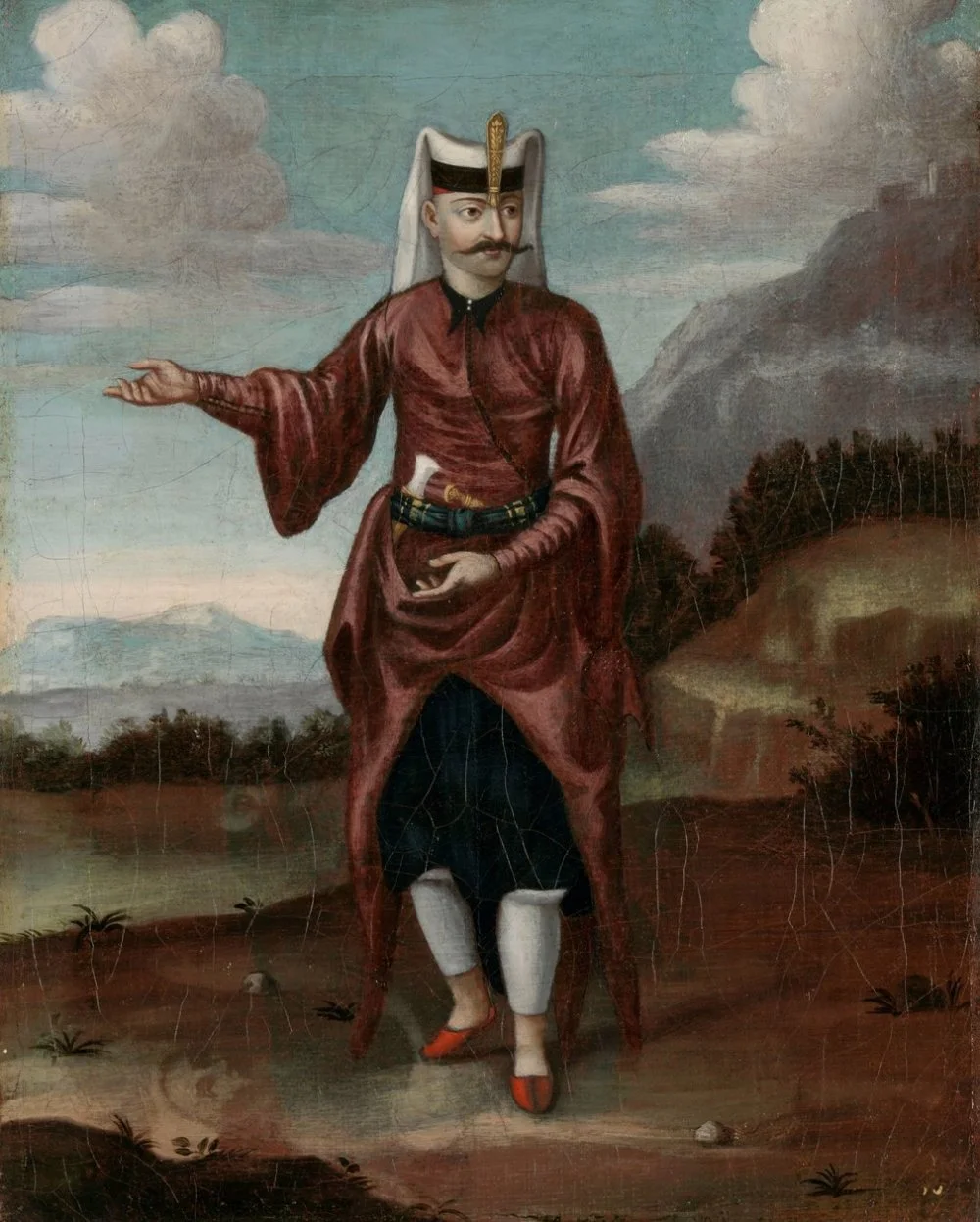
Jean Baptiste Vanmour “A Soldier of the Janissaries” between 1700 and 1737 /Rijks Museum, Amsterdam
One’s Own Among Strangers, a Stranger Among One’s Own
During the period when the empire was being established as well as later, the Ottoman army consisted of different branches of the army, mercenaries and allies, whose structures and characteristics were very different and often could not be hierarchized. Some of them were ethnic or tribal troops, such as the Tatarlar, Yörükler, or Voynuklar from among the free Slavs. Others were provincial or frontier troops who performed military service in return for exemption of taxes on the land allotted to them. There were also those who conducted raids independently outside the Ottoman borders and paid tribute to the sultans from their booty, but were occasionally used for specific military tasks.
All of them more or less retained their former regional identity, governance, and loyalty, including to the Anatolian Turkic beyliks,i
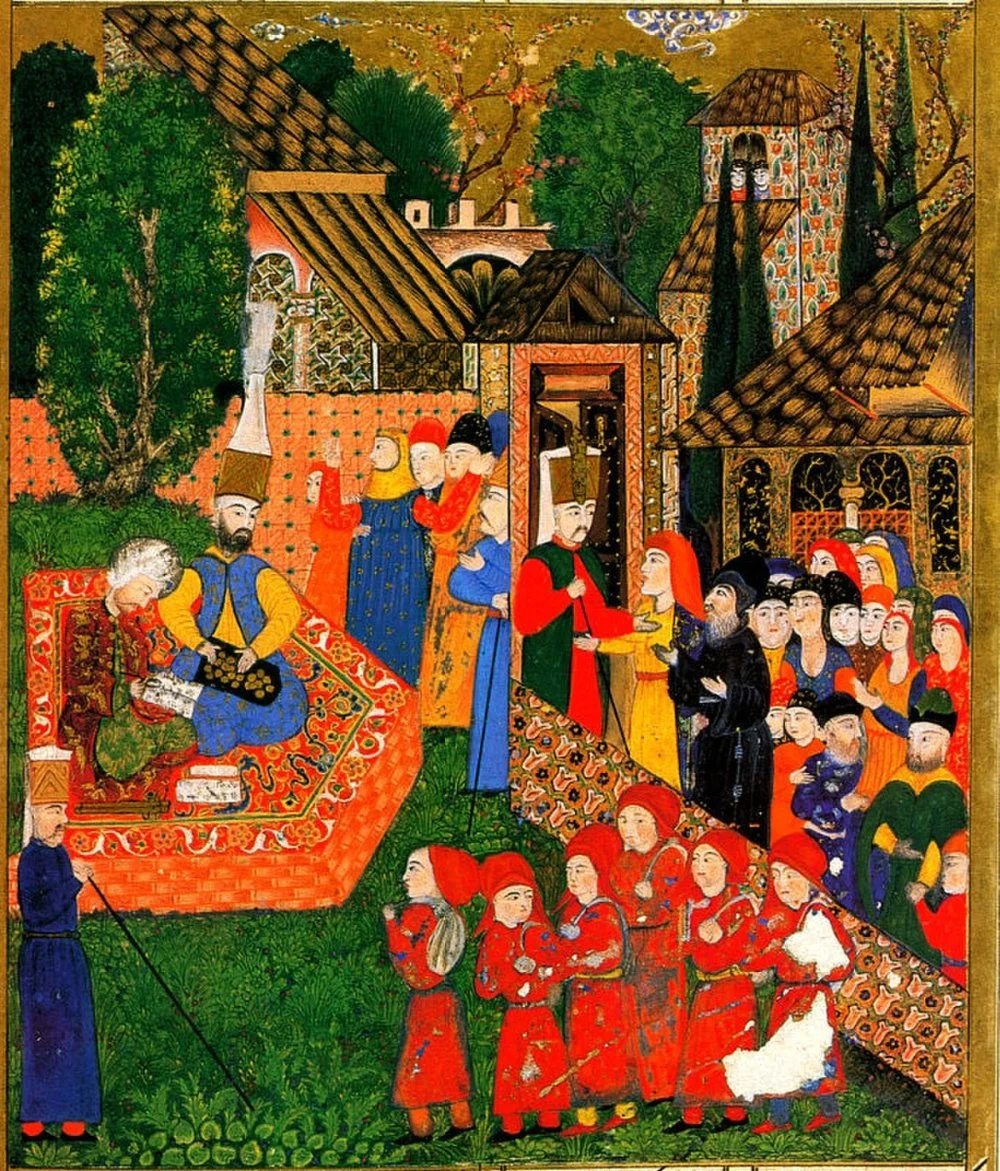
Ali Amir Beg. Janissary Recruitment in the Balkans. Illustration of the registration of Christian boys for the devşirme ("collecting"). Ottoman miniature painting, 1558./Süleymannâme, Istanbul, Topkapi Palace Museum
Paradoxically, the decision to create a permanent and professional army of Christians from Albania, Bulgaria, Bosnia, Hungary, Greece, and Serbiai

Interestingly, Murad I did not demonstrate any special trust in his relatives and went down in history as the first Ottoman sultan who committed fratricide and then also as the first sultan who committed infanticide, thus creating a tradition that would colorfully play out in Turkish TV shows six and a half centuries later.
Slaves at the Pinnacle of Power
Murad I began the reform of the Ottoman army by creating an entirely new military corps called Kapıkulu (Turkish for ‘Slaves of the Gate’, meaning the gates of the palace of the Ottoman Sultan), which was selected exclusively from Christians, mostly from the Balkans. The military corps of Kapıkulu included Janissaries and other highly specialized infantrymen (gunners, artillerymen, bombardiers, and grenadiers), as well as cavalry. This army, unlike the early Ottoman branches of the military, was permanent and professional, that is, they were specially trained in a particular military art, engaged only in that business, and were paid a fixed monthly salary, plus what we would call a performance bonus. These bonuses, however, would lead to disaster, but we’ll delve into that issue shortly.
As the name suggests, the Kapıkulu were primarily considered the personal slaves (or servants) of the sultan. As a result, he could execute any of them, and even the grand vizier at the head of an army of 100,000, without trial if he so wished, although formally, the execution of even the poorest commoner required legal authorization. Accordingly, this new army was created primarily to protect the court, and it reported directly only to the Ottoman sultan. They lived nearby, sometimes in the sultan’s palaces, but most importantly, they were separated from the rest of the population. They could be distinguished from the common people by their brightly colored clothes and freshly shaved cheeks, for, except for the commanders, they were forbidden to grow beards.
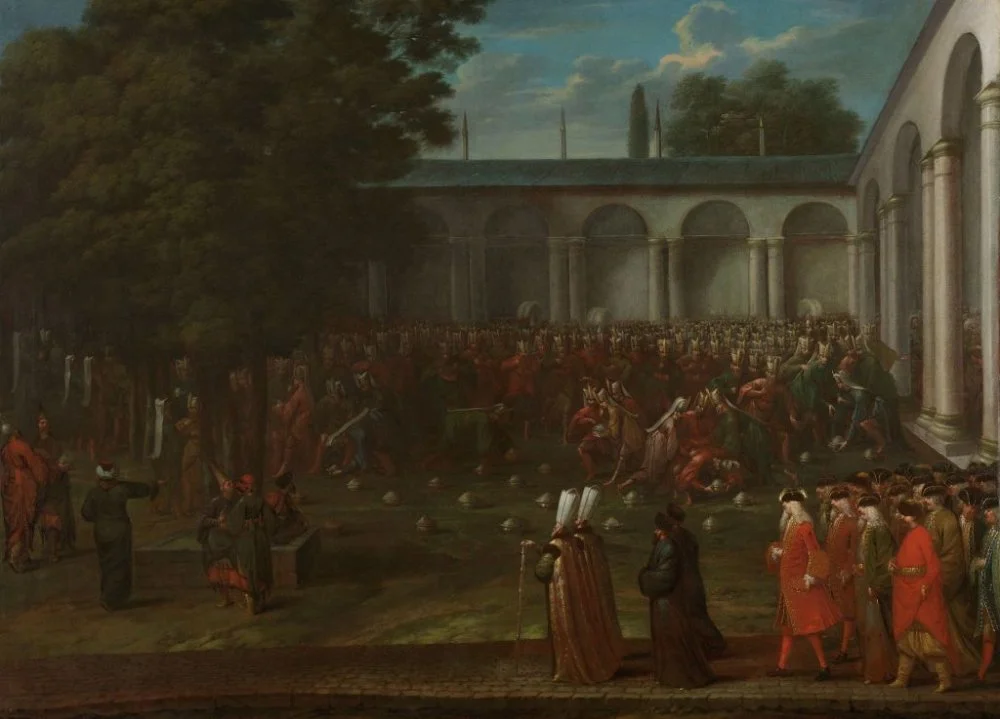
Jean Baptiste Vanmour. Cornelis Calkoen on his Way to his Audience with Sultan Ahmed III. circa 1727-circa 1730./Getty Images
The first step towards the organized recruitment and preparation of Christian boys for permanent military and administrative service, including in the Kapıkulu Corps, was the creation of the Acemi Ocağı (the ‘Foreign Corps’ or ‘Corps of New Recruits’).1
The strong and brave candidates were taken into the Janissary Corps (Yeniçeri Ocağı in Turkish), sometimes after seven to eight years of preliminary training in Acemi Ocağı. The handsome ones were chosen for court service (İç oğlanı in in Turkish, meaning ‘inner or palace boys’), and the strong, stately, and good-looking ones went to the ‘gardeners’. The smartest went to the ‘inner school’ (Enderûn Mektebi in Turkish), where they were taught everything from Islamic theology and foreign languages to mathematics and diplomatic protocol. All of this was achieved despite the fact that they were all carefully selected from hundreds of thousands of Christian boys throughout the European lands of the empire.
Initially, Christians were chosen for military service from among the Christian prisoners through a then-established principle called pençik (in Turkish, pençik or penç ü yek means one fifth). According to the law, every fifth prisoner was taken into the sultan’s army. The tradition of warrior-slaves had long existed in the Islamic world, and they were called gulam or gilman (from the Arabic for ‘boy’ or ‘servant’). In the Arab Caliphate and other Muslim states, these servant boys were mostly recruited from the Turkic-speaking peoples of Central Asia, including the ancestors of the Ottomans themselves. They were considered the most loyal and elite troops, serving primarily in the palace of rulers and caliphs, and some of them later became rulers themselves, such as the Mamluks, which is Arabic for ‘slave’.
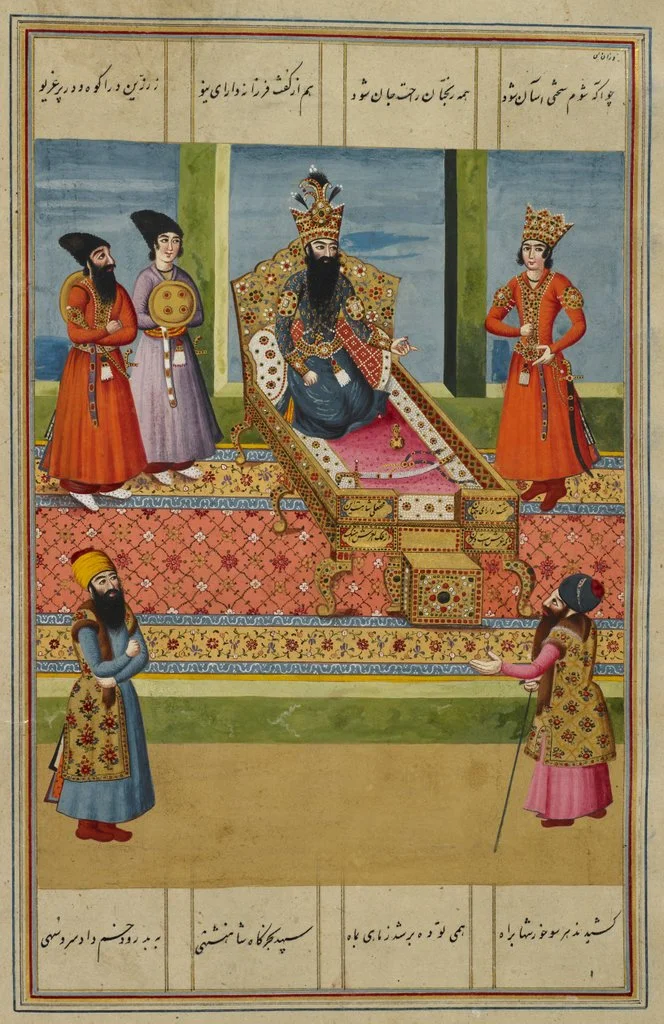
Fath ‘Ali Shah seated on the Peacock Throne attended by a prince (‘Abbas Mirza?) and two ‘ghulams’ with his shield and mace, giving audience to two ministers. 1810/Wikimedia commons
The Gilman or Mamluks formally ceased to be slaves after they adopted Islam. Since they were foreigners in the land of the caliphs, with no family ties or regional attachments, their future and well-being in theory depended only on the ruler, which made them loyal and steadfast. This was also the understanding of the Ottoman sultans, the descendants of Turkic tribes, who had first-hand knowledge of the captive army in the service of various Muslim dynasties, from the Abbasids to the Seljuks.
Beauty Is a Powerful Force
However, the most important innovation the Ottomans made regarding recruiting elite troops from among Christians was the gradual abandonment of the pençik, which was available only in border areas or during military campaigns and did not allow for much selectivity: one took what one could get. Gradually, the Ottomans switched to a completely new model of recruiting Janissaries called devşirme (meaning ‘collection or recruitment’). The catalyst for the popularity of this method was Timur, who defeated the Ottoman army and captured Sultan Bayezid I (the son of Murad I) in 1402, which led to civil war and temporarily halted the Ottoman raids on neighboring countries and, consequently, the influx of prisoners into the army.

Haseki agasi, Lieutenant of the imperial guards. Drawing from Album of Turkish Costume Paintings/ Wikimedia commons
Unlike the spontaneous and poorly planned pençik, devşirme was carried out among Christian subjects from the European provinces of the empire itself. It was regulated by a special law called Devşirme kanunnamesi, and its execution was supervised by a multitude of officials who meticulously documented every step. Devşirme was primarily used to recruit Janissaries, and only their commander could initiate it. He would submit a request for a certain number of recruits to the divan, the supreme legislative body. The divan would then issue a fermân, or sultan’s decree, specifying the number of recruits for each region.
Every three to five years (sometimes less frequently), boys between the ages of eight and twenty were recruited from only among the native Christians at the rate of one boy per forty families, for whom the church baptismal registers were checked in detail. All data were recorded in two separate books in the presence of two responsible Janissaries, a kadı (a judge), a sipâhi (cavalryman), and the kethüda (head of the local community). These duplicates were then taken to the capital by different routes. All the information about each person was recorded: name of village, district, region, date of birth, detailed description of appearance, names of parents, and military commander of the settlement. Boys and young men were then sent to the Janissary Corps in the capital in groups of 100–200 dressed in the conspicuous bright red uniforms of the ever-fashionable Janissaries, which, of course, made their escape more difficult. The death or illness of one of the boys during the journey had to be documented in the presence of a local magistrate, with a confirmation of appearance and an entry in a register. This process made it difficult to replace or release someone if the officials had been bribed. There were also cases of boys being recruited in villages by swindlers using false documents, which often ended with the hands of these overly enterprising gentlemen being chopped off.
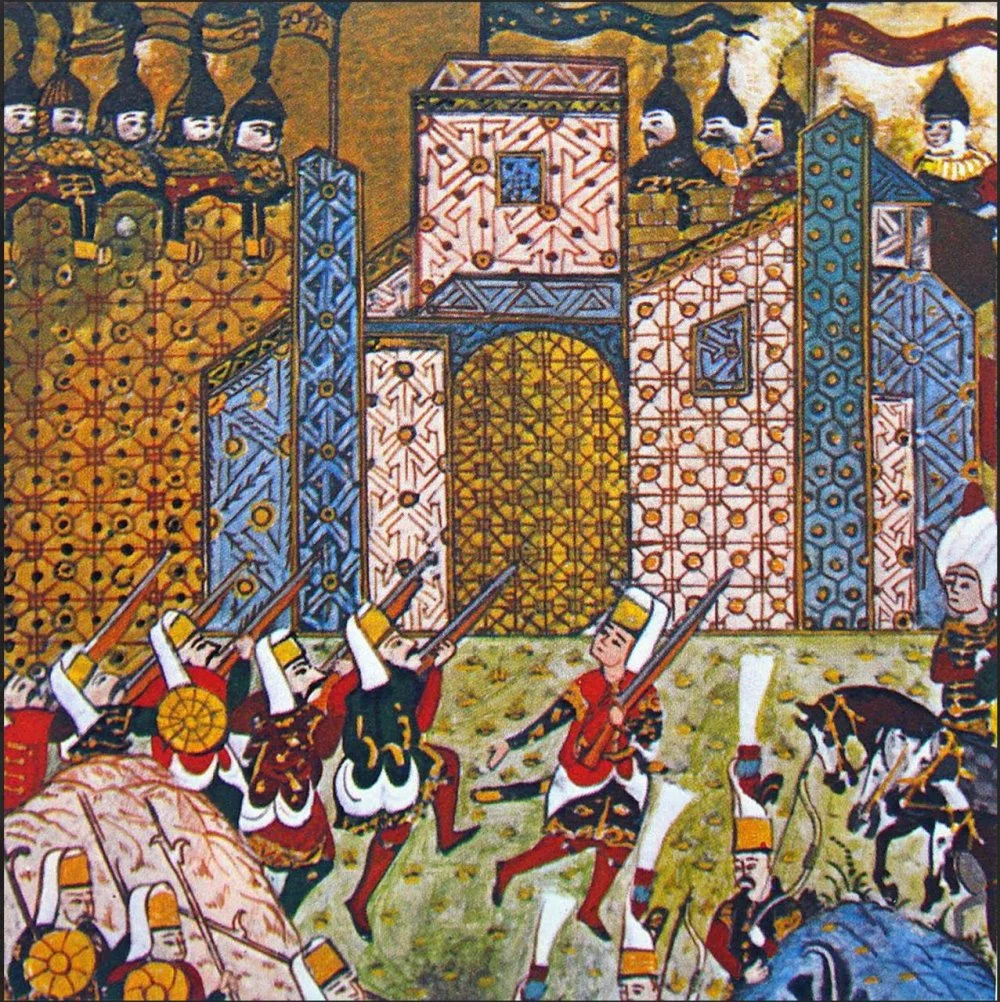
miniature ottomane des Janissaires luttant contre les chevaliers de Saint Jean au siège de Rhodes de 1522. Peinture par Matrakci Nasuh (1480-1564), 1558
Strange as it may seem, the Ottomans did not fear under-recruitment and desertion in this matter of vital importance to the state, but rather the opposite—the infiltration of undesirable elements among the recruits. These included the Turks, Muslims, Jews, urban dwellers, merchants, and members of criminal groups, as well as those for whom service in the ranks of the Janissaries seemed an attractive career. The ‘new troops’ were to consist exclusively of strong, healthy, but innocent and good-looking, Christian boys from the quiet hinterlands. For this reason, the devşirme excluded anyone over twenty years old, the circumcised, married, only sons in the family, stunted, ugly, orphans, shepherds, bald, and beardless. In addition, those who were skilled and master craftsmen, those who had already learned Turkish, and those who had already lived in Istanbul were also excluded.
Upon their arrival in the capital, these Christian boys were carefully checked against the descriptions of their appearance. If a single substitution or discrepancy was found, the entire group was barred from joining the Kapıkulu (they were simply sent to the cannon foundries), and those involved were dismissed and punished. After the inspection, the boys were circumcised and converted to Islam.
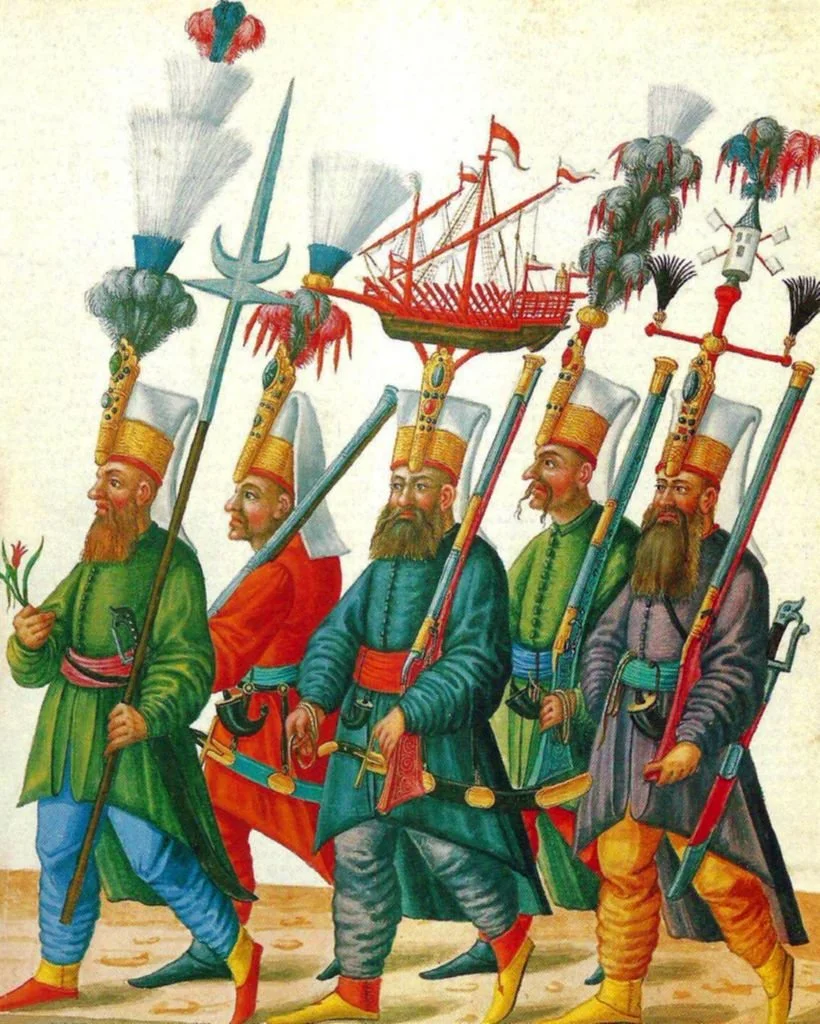
The Janissaries. From the Codex Vindobonensis 8626, fol 13. Museum: Austrian National Library, Vienna/Alamy
Strangely enough, the transformation of innocent Christian boys into the most fearless, brutal, and skilled warriors of their time, terrorizing three continents, did not begin with grueling training and daily honing of fighting skills, but with agricultural work in Anatolian villages. After the best-looking ones had been chosen for the court and the strongest for the ‘gardeners’, all the rest were temporarily ‘sold’ to Turkish families in Anatolian villages for six to seven years. Here, they learned the Turkish language and Islam in everyday life, worked in the fields in the same distinctive red clothes, and apparently accumulated anger. It was strictly forbidden to transfer them to the families of city dwellers, especially Istanbul dwellers, artisans, scholars, and judges. Adapting to the urban environment, let alone learning a trade and earning one’s own living, prevented, in the opinion of the Ottoman government, the transformation of homeless strangers into brutal warriors loyal to the sultan.
After several years of living with a Turkish foster family and undertaking hard work in the fields of the Anatolian countryside—the distance from the sea and from the main roads to prevent escape was an important criterion in their assignment—they were sent to their janissary detachment as completely different men with different names. From then on, they were united not by their Christian faith, nor by their native, almost forgotten languages, but by their harsh fate, by thoughts and feelings buried deep in their hearts, and by a sense of brotherhood. Brotherhood was all the Janissaries had, and their whole lives would be built around it.
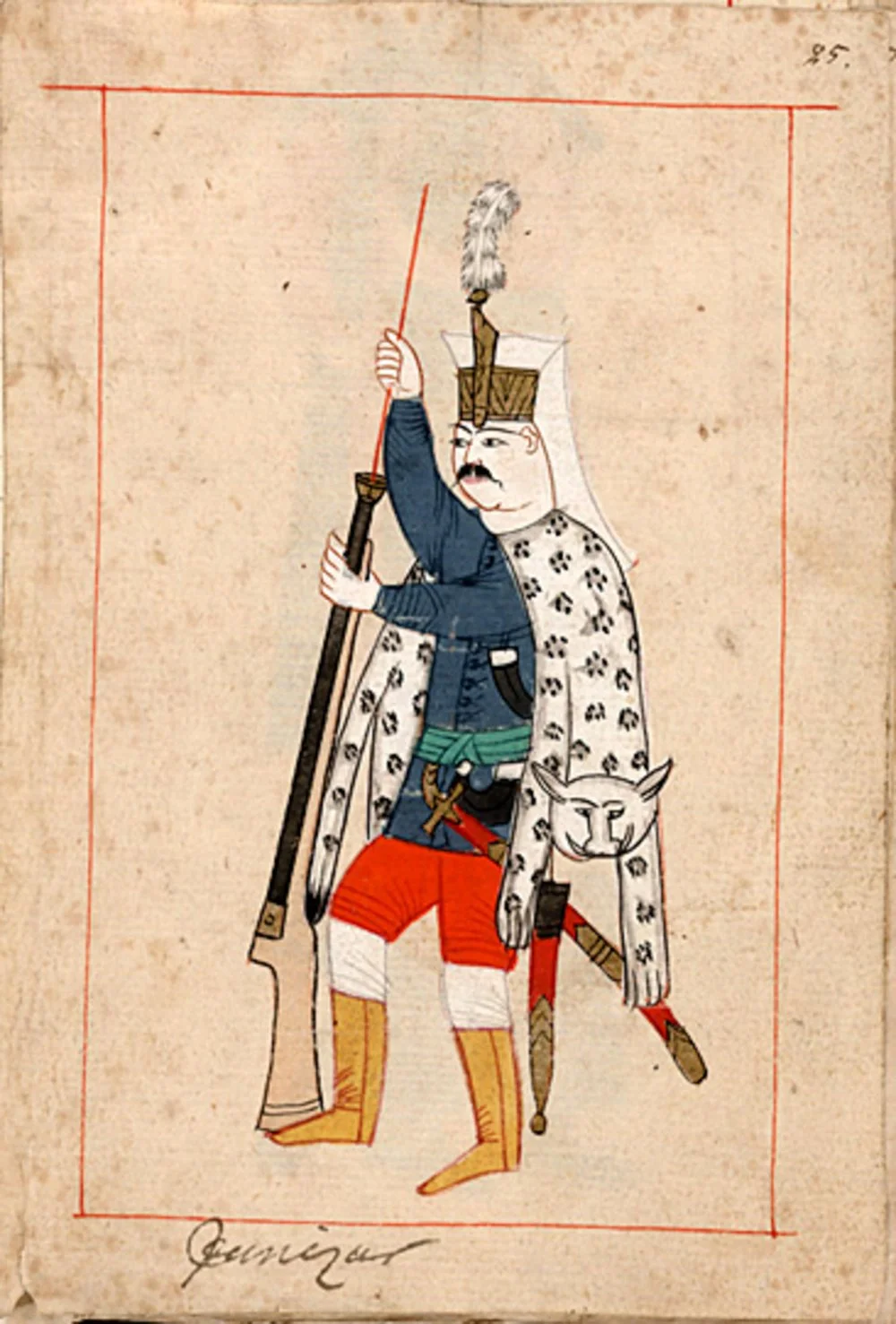
Janissary From Ralamb Costume Book. Miniatures In Indian Ink With Gouache And Some Gilding. They Were Acquired In Constantinople In 1657-58 By Claes Rålamb Who Led A Swedish Embassy/Alamy
THE MORE YOU SWEAT IN PEACE, THE LESS YOU BLEED IN WAR
Once they joined the Janissaries came the easiest part—daily, constant, and exhausting combat training, interrupted by lunch or dinner, reading of poetry, or praying. The military prowess of the Janissaries was a matter of boundless pride for the sultans, and many of them, in between state affairs, liked to watch the training process, especially archery. For this, the Janissaries were invited to the Okmeydanı (Arrow Square), a special shooting range with a balcony for the sultan built by Mehmed II. It is not at all surprising then that the sons of the sultans were trained by the Janissaries.
Future janissaries often trained in groups as part of their regiment. Despite the symbolic, almost spiritual attachment the Janissaries had to the sword, they were skilled in archery and arquebus shooting, making up a large part of their training. They also had general physical training sessions, which often took on a playful and competitive form.
Every week, the janissaries would parade in full uniform and with music in the Etmeydanı (Butcher’s Square) in the center of Istanbul, where spectators could watch their demonstrations, mock battles, and tactical maneuvers.
You can read the second part of our story about the Janissaries here.
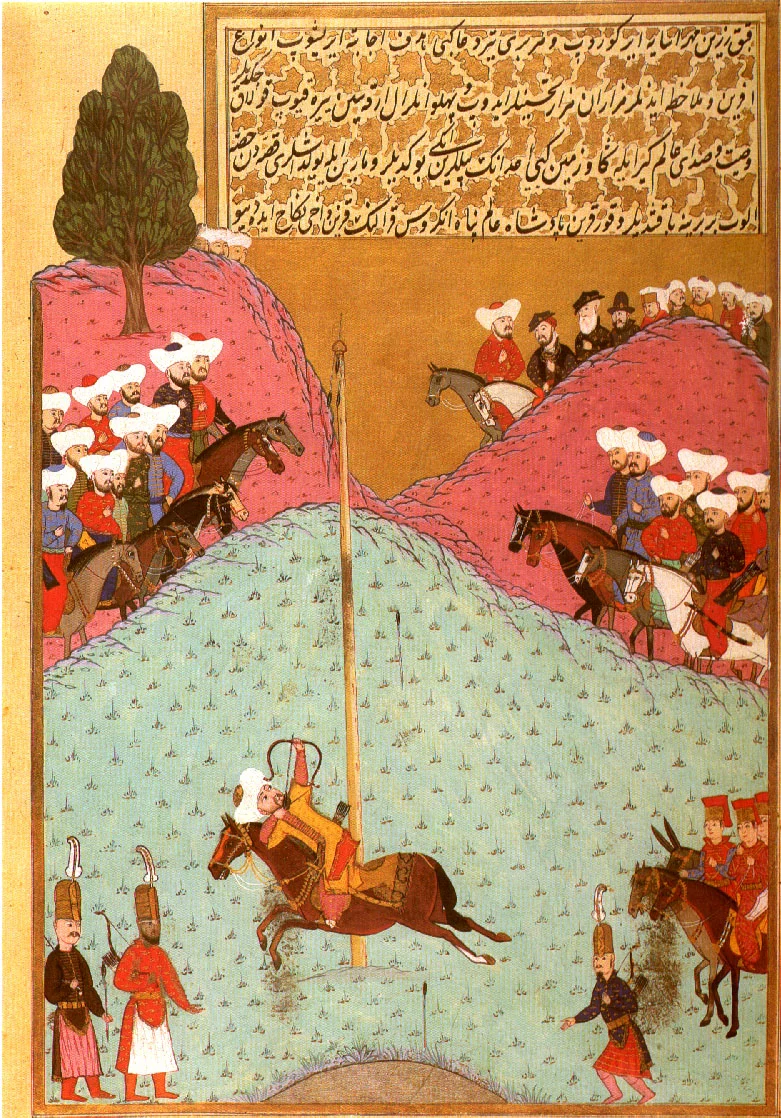
Sultan Murad II at archery practice. 1584/Wikimedia commons
